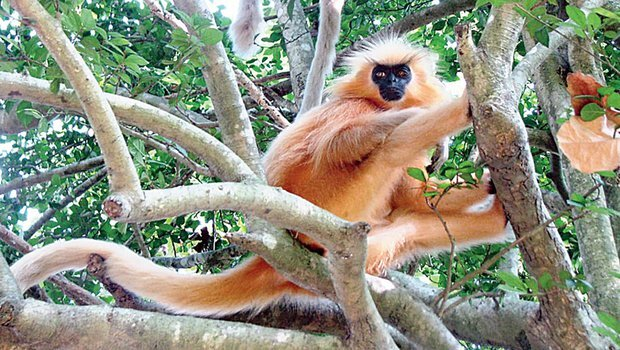Golden Langur | 05 Feb 2022
Why in News?
Assam villagers are opposing the sanctuary tag for golden langur habitat.
What is the Issue?
- The Assam Forest Department had issued a preliminary notification for converting the 19.85 sq. km. patch of forest into the Kajoijana Bamuni Hill Wildlife Sanctuary.
- Kakoijana Reserve Forest is one of the better-known homes of the golden langur.
- The villagers demanded that the “conventional idea of wildlife sanctuary” be dropped and the reserve forest converted into a community forest resource “using Forest Rights Act, 2006, to ensure community co-managed system of participation for sustainable conservation.
- The villagers pointed out that the conservation efforts of the locals had helped the authorities concerned to restore the forest canopy from less than 5% to more than 70%, and the golden langur population from less than 100 to more than 600 over almost three decades.
What is the Difference between Wildlife Sanctuary, Reserve Forest and Community Forest Resource?
- Wildlife Sanctuary: It is the place that is reserved exclusively for wildlife use, which includes animals, reptiles, insects, birds, etc. wild animals, especially those in danger of extinction and the rare ones, so that they can live in peace for a lifetime and keep their population viable.
- The Wildlife Protection Act, 1972 empowers the central and state governments to declare any area a wildlife sanctuary, national park or closed area.
- Reserve forests: They are the most restricted forests and are constituted by the State Government on any forest land or wasteland which is the property of the Government. In reserved forests, local people are prohibited, unless specifically allowed by a Forest Officer in the course of the settlement.
- Community Forest Resource: According to Section 2(a) of the Forest Rights Act, it is the customary common forest land within the traditional or customary boundaries of the village or seasonal use of landscape in the case of pastoral communities, including reserved forests, protected forests and protected areas such as sanctuaries and national parks to which the community had traditional access.
What do we know about Golden Langurs?
- Scientific Name: Trachypithecus geei
- About: Golden langurs can be most easily recognized by the color of their fur, after which they are named.
- It has been noted that their fur changes colors according to the seasons as well as geography (region they live in).
- The color of the young also differs from adults in that they are almost pure white.
- They are highly dependent on trees, living in the upper canopy of forests. They are also known as leaf monkeys.
- Habitat: It is endemic to western Assam, India, and southern Bhutan.
- Their habitat is restricted to the region surrounded by four geographical landmarks: the foothills of Bhutan (North), Manas river (East), Sankosh river (West), and Brahmaputra river (South).
- Threats:
- Restricted Habitat: As mentioned above, their habitat is restricted by natural boundaries further increasing the threat of extinction.
- Habitat Fragmentation: Their habitat in Assam has fragmented drastically especially after a thrust on rural electrification and massive deforestation.
- Inbreeding: Obstructions such as wires, and gaps in the forest due to felling, have increased the threat of inbreeding among golden langurs.
- Conservation Efforts:
- The Central Zoo Authority, New Delhi entrusted the state zoo with the project for the conservation breeding of golden langur in Assam in 2011.
- The recorded estimation in Assam in 2009 was 5,140. Census in 2020 could not be completed due to the Covid-19 lockdown.
- Protection Status:

